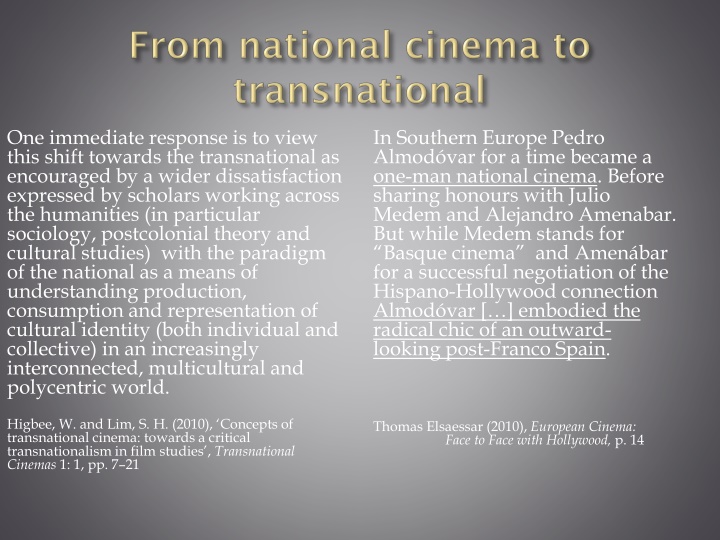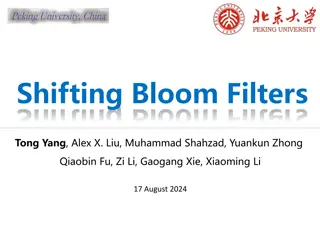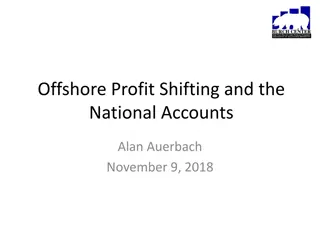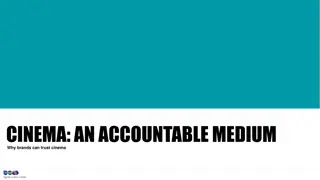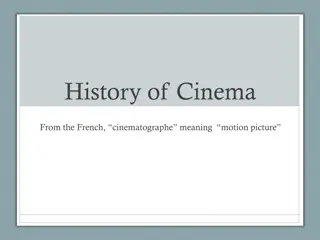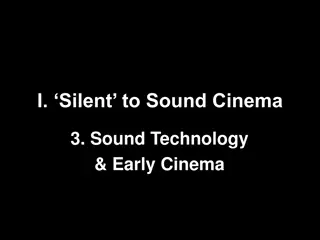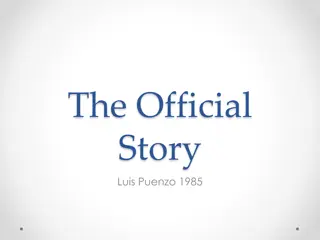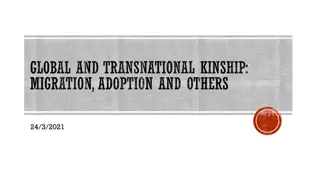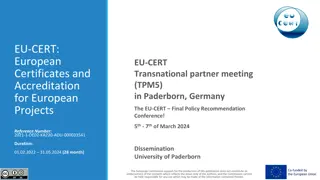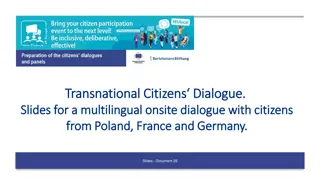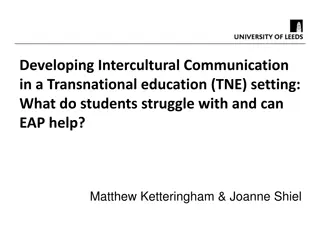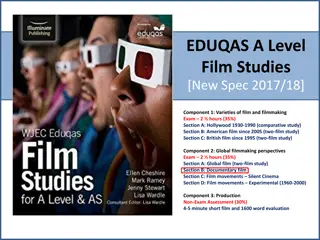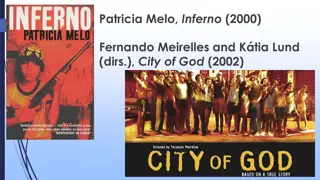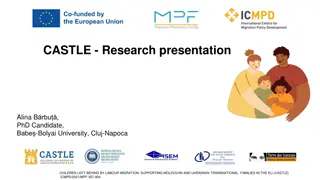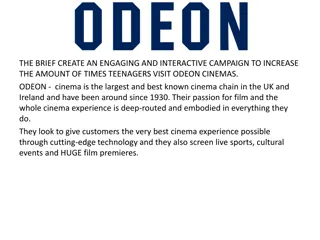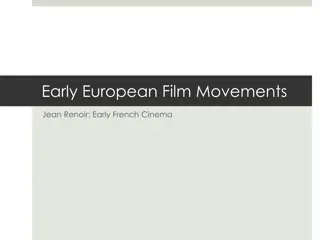Shifting Perspectives in Transnational Cinema Studies
Scholars across humanities are shifting towards a transnational approach in cinema studies to explore cultural identity in a globalized world. The chapter maps new ways to analyze Latin American cinema beyond national contexts, emphasizing the resistance to cultural homogenization and the preservation of artistic, social, and political values in transnational filmmaking.
Download Presentation

Please find below an Image/Link to download the presentation.
The content on the website is provided AS IS for your information and personal use only. It may not be sold, licensed, or shared on other websites without obtaining consent from the author.If you encounter any issues during the download, it is possible that the publisher has removed the file from their server.
You are allowed to download the files provided on this website for personal or commercial use, subject to the condition that they are used lawfully. All files are the property of their respective owners.
The content on the website is provided AS IS for your information and personal use only. It may not be sold, licensed, or shared on other websites without obtaining consent from the author.
E N D
Presentation Transcript
One immediate response is to view this shift towards the transnational as encouraged by a wider dissatisfaction expressed by scholars working across the humanities (in particular sociology, postcolonial theory and cultural studies) with the paradigm of the national as a means of understanding production, consumption and representation of cultural identity (both individual and collective) in an increasingly interconnected, multicultural and polycentric world. In Southern Europe Pedro Almod var for a time became a one-man national cinema. Before sharing honours with Julio Medem and Alejandro Amenabar. But while Medem stands for Basque cinema and Amen bar for a successful negotiation of the Hispano-Hollywood connection Almod var [ ] embodied the radical chic of an outward- looking post-Franco Spain. Higbee, W. and Lim, S. H. (2010), Concepts of transnational cinema: towards a critical transnationalism in film studies , Transnational Cinemas 1: 1, pp. 7 21 Thomas Elsaessar (2010), European Cinema: Face to Face with Hollywood, p. 14
Jamon Jamon A hot, sexy and outrageously funny farce - a steamy mosaic of passion and desire in a world populated by man-eating women and ham-eating men. Huevos de oro A black comedy that revels in excess sexual intrigue, high kitsch and phallic imagery. Elle A globe-spanning, ironic portrait of kitsch and the new rich.... Not the subtlest exploration of the priapic urge. Teta i la lluna Strange, sexy and cheerfully insane, this slice of Spanish surrealism is eye-catching. (Chris Tookey webpage) Bonkers and superb Una storia con molto amore, molta luna, e grande tette.
The purpose of this chapter is to map out new ways to think about contemporary Latin American cinema that take us beyond both the traditional close reading of national films within national contexts, and the dismissive notions of new trends in co-production as signifying nothing more than commercially driven expressions of global capital in movement. (Stephanie Dennison, Contemporary Hispanic Cinema. Interrogating the Transnational in Spanish and Latin American Film, 2013, p. 1) There is nothing inherently virtuous about transnationalism and there may even be reason to object to some forms of transnationalism [ ] My own view is that the more valuable forms of cinematic transnationalism feature at least two qualities: a resistance to globalization as cultural homogenization; and a commitment to ensuring that certain economic realities associated with filmmaking do not eclipse the pursuit of aesthetic, artistic, social, and political values. (Mette Hjort, On the Plurality , p. 15)
These multidirectional perspectives are recognised as transnationalism from above and transnationalism from below . The first refers to the lite migration and transnational capitalist class.[...] Transnationalism from below is depicted instead by the lion s share of immigrants, who have propelled the growth in informal economies. Blanc as cited by Deborah Shaw in Dennison, p. 36 These categories assume intertextuality in that every film made has been consciously or unconsciously shaped by pre-existing cultural products from all over the world. This, in turn, also infers that national cinema cannot exist in isolation, and here we can apply Dudley Andrew s notion of a world systems approach. In his words: You can t study a single film, nor even a national cinema, without understanding the interdependence of images, entertainment, and people all of which move with increasing regularity around the world. The movies are a model for the glocal Andrews applies the analogy of genealogical trees to traditional studies of national cinema in the ways that scholars have examined each nation s cinema as a discrete object of study, arguing that their elaborate root and branch structures seldom interfere with one another (Andrew , p. 21). He critiques this methodology and advocates the use of the concept of waves to replace that of trees. A world systems approach is characterised, then, by waves of influence between national cinemas and from film to film in terms of approach, narrative and visual style.
Unlike the tree, the rhizome is not the object of reproduction: neither external reproduction as image-tree nor internal reproduction as tree-structure. The rhizome is an antigenealogy. It is a short-term memory, or antimemory. The rhizome operates by variation, expansion, conquest, capture, offshoots. Unlike the graphic arts, drawing, or photography, unlike tracings, the rhizome pertains to a map that must be produced, constructed, a map that is always detachable, connectable, reversible, modifiable, and has multiple entryways and exits and its own lines of flight. It is tracings that must be put on the map, not the opposite. In contrast to centered (even polycentric) systems with hierarchical modes of communication and preestablished paths, the rhizome is an acentered, nonhierarchical, nonsignifying system without a General and without an organizing memory or central automaton, defined solely by a circulation of states. What is at question in the rhizome is a relation to sexuality but also to the animal, the vegetal, the world, politics, the book, things natural and artificial that is totally different from the arborescent relation: all manner of "becomings." Deleuze & Guattari (1987), A Thousand Plateaus (U. Minnesota Press) p. 22.
transnational modes of production, distribution and exhibition transnational modes of narration cinema of globalisation films with multiple locations exilic and diasporic filmmaking film and cultural exchange transnational influences transnational critical approaches transnational viewing practices transregional/transcommunity films transnational stars transnational directors the ethics of transnationalism transnational collaborative networks national films epiphanic transnationalism affinitive transnationalism milieu building transnationalism opportunistic transnationalism cosmopolitan transnationalism globalizing transnationalism auteurist transnationalism modernizing transnationalism experimental transnationalism Mette Hjort, On the Plurality of Cinematic Transnationalism , in World Cinemas, Transnational Perspectives (2009), pp. 12 33 D Shaw in Dennison , p 52
Espana, una, grande y libre Poster for Calabuch prioritising foreign stars and toponym, of recognisably non- Castilian phonetics. (available on internet) Berlanga no es un comunista. Es peor que eso: es un mal espa ol. Francisco Franco siempre la lengua fue companera del imperio. Nebrija
Calabuch, distinctively non-Spanish (i.e. catalan) phonetic reference. All films dubbed into Spanish not spoken by foreign stars. What s in a name? Town, bull, painter, boats [Esperanza!] Jorge first meets speaks in Latin to Roman soldiers! Edmund Gwenn (Oscar Miracle on 34th Street, 1947) Valentina Cortese Thieves' Highway (Dassin; 1949); The Glass Mountain (1949); The Barefoot Contessa (1954) Franco Fabrizi. habitual in films by Antonioni and Fellini. School teacher instructs the scientist in the secret language of flowers. In the classroom we see multiplication tables: & algebra; complex formulae which Jorge inscribes on the wall of his cell Don Ramon s lighthouse we see explicatory illustration of the marine semaphor code. soundtrack and dubbing flawed. stars and technical issues compromise hegemony of Castilian during the wedding cerimony [music] and card games agains policeman and priest (regime) we see gestures, glances, nods .
Tired of working in the construction of atomic bombs and worried about the destructive power of his invention, a top American scientist runs away from his country and takes refuge in the anonymity of a peaceful village in the Mediterranean coast called Calabuch. The scientist, who is taken for a kind-hearted tramp, fits in completely with the lifestyle of Calabuch. He befriends inhabitants, helps them solve their problems and takes part in municipal activities. When the local fiestas start, he makes rockets and fireworks which reach heights never seen in the area. Those fireworks alert the international authorities as to the whereabouts of the missing scientist. When the US fleet goes there looking for him and, despite the resistance of the villagers, Jorge is forced to go back home, aware he goes with the friendship and love of all Calabuch.
Holbach represents every activity of individuals in their reciprocal intercourse, i.e, speech, love, etc., as a relation of utility and exploitation. The real relations which are here presupposed, are therefore speech, love, etc., i.e. specific manifestations of specific individual qualities. These relations are thus not allowed to have their own significance but are depicted as the expression and representation of a third relation which underlines them, utility or exploitation. The material expression of this exploitation is money, which represents the value of all objects. Men and social relationships. K Marx, Selected Writings in Sociology and Social Philosophy (Penguin1963, pp. 62-75) A grocer who dreams is offensive to the buyer, because such a grocer is not wholly a grocer. Society demands that he limit himself to his function as a grocer... There are indeed many precautions to imprison a man in what he is, as if we lived in perpetual fear that he might escape from it, that he might break away and suddenly elude his condition. J P Sartre, Being and Nothingness: An Essay on Phenomenological Ontology (Methuen, 1969) p. 60.
The Irish Connection: Poster for Innisfree in Spoof cinerama fashion typical of trailer for Ford s original. Available on internet J L Guerin s Homage to The Quiet Man.
Whistful myth of film set: evocation of idyll of Old Country as depicted by postcard (creative commons licence) Still from film of locals in Cong, west of ireland, amongst ruins of rural cottages Explanation (in Irish ) of construction, design and room allocation in old cottages
CATALONIA MODERNITY TRADITION URBAN RURAL CULTURE WORK LEISURE HEAVEN SPAIN NATURE HELL Martin Macloone (Irish Film, 2000: 54) FORDIAN NATIONAL TOPOI PERSONAL SPACE COMMUNAL SPACE LANGUAGE IDIOM LANDSCAPE CULTURAL HERITAGE VIOLENCE ANTI-IMPERIALISM HOME PUB, CHURCH IRISH/ENGLISH BLARNEY/GUFF STUDIO SETTINGS ARTEFACTS; SONGS MISOGYNY; DONNYBROOK REBELLION/IRA
